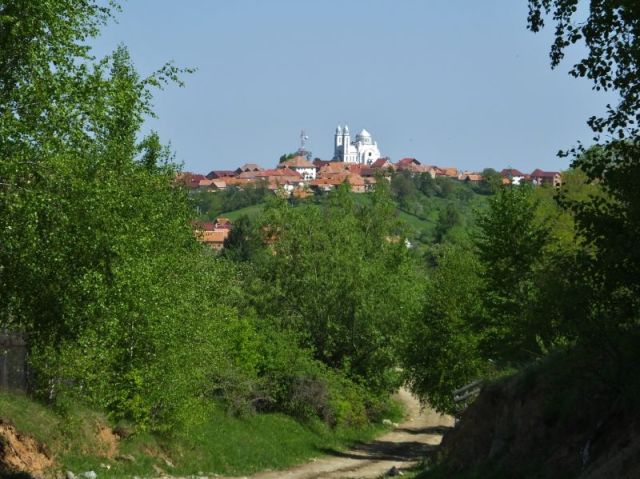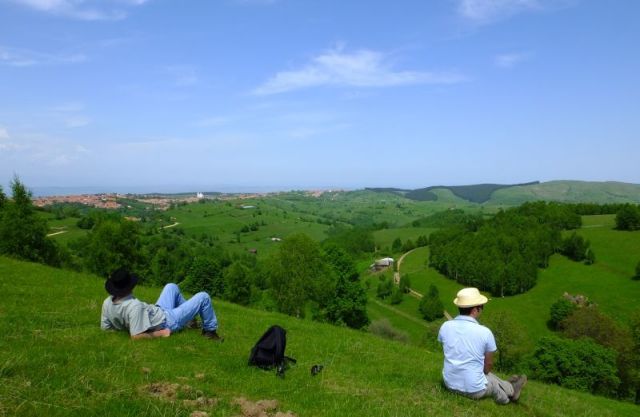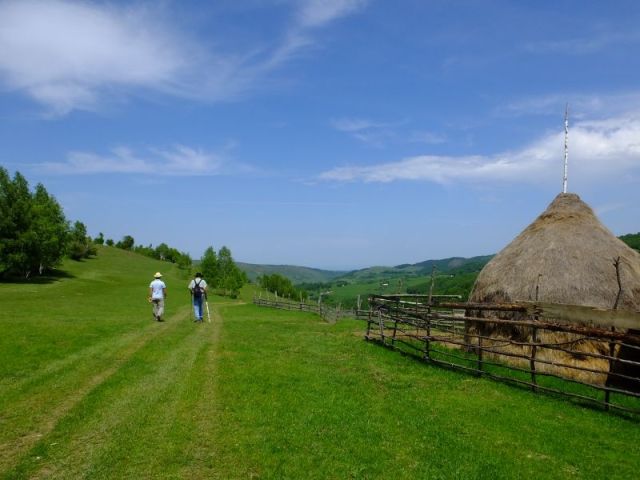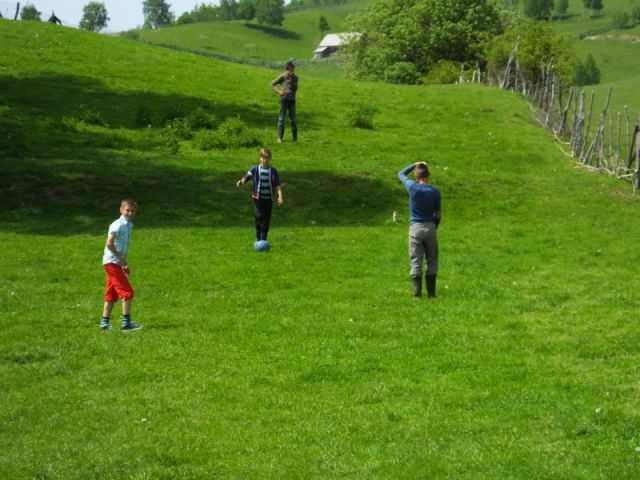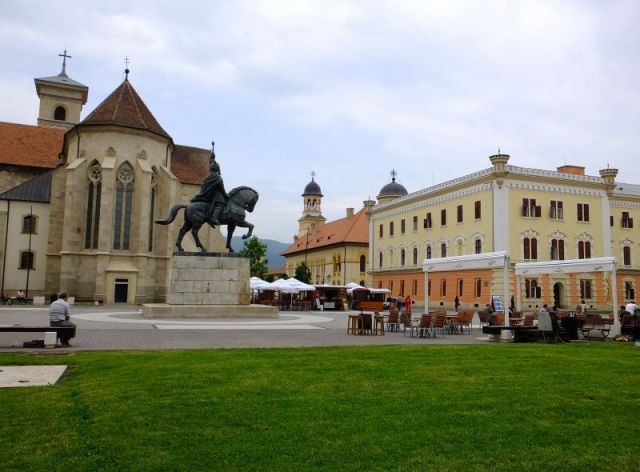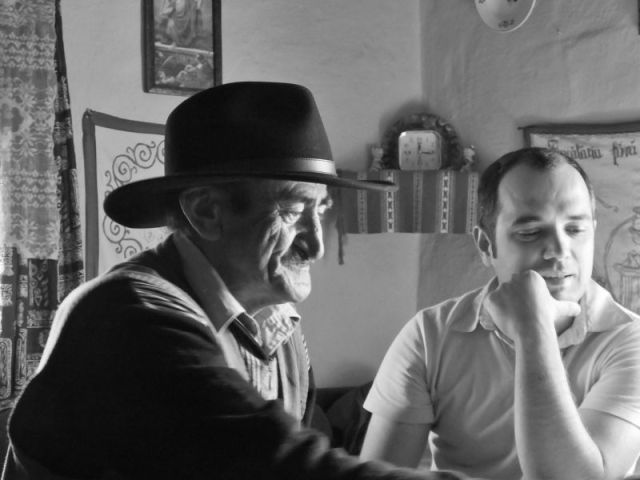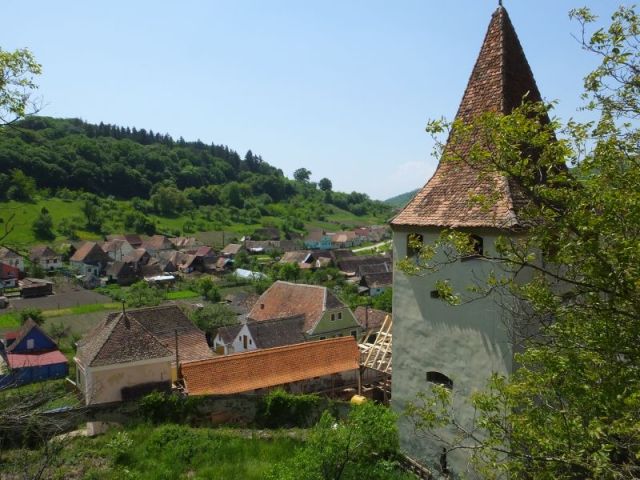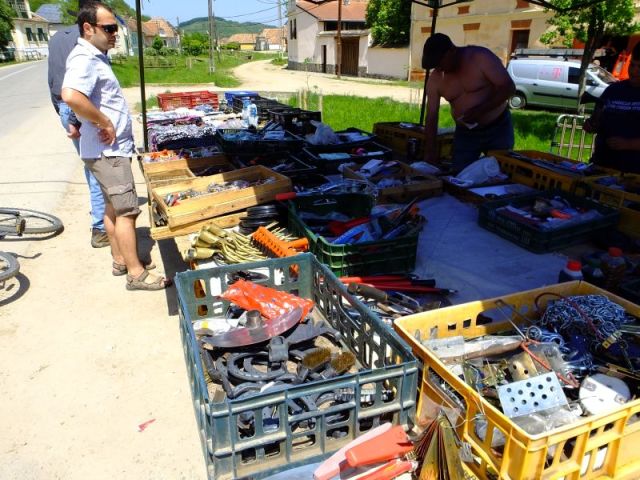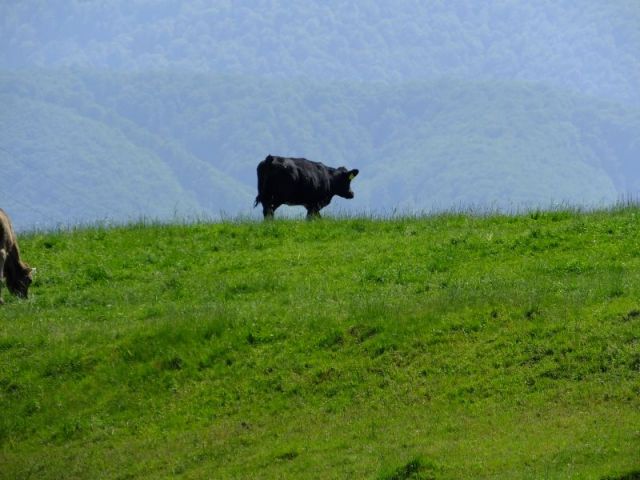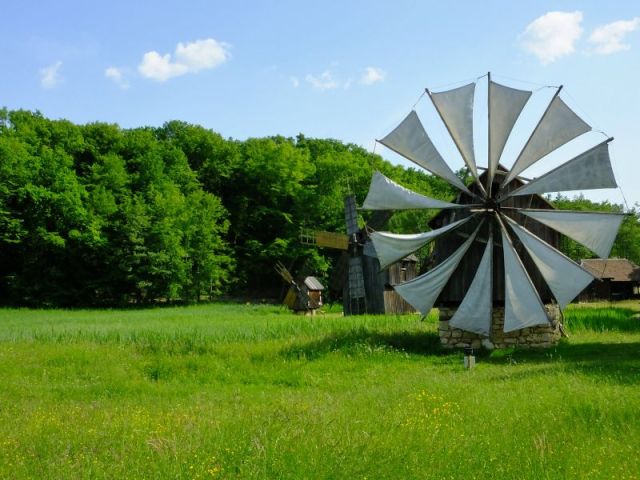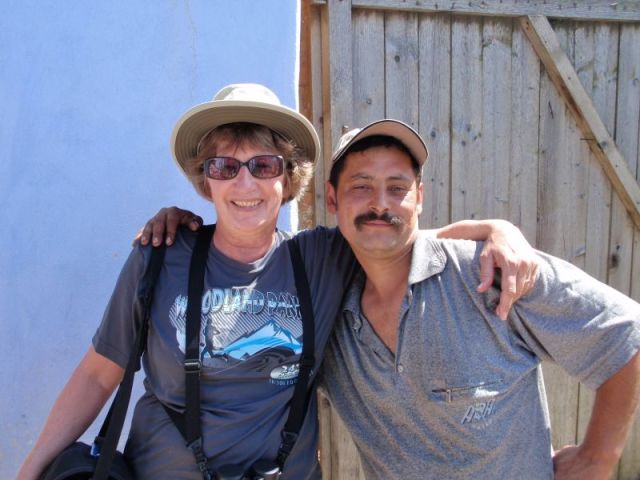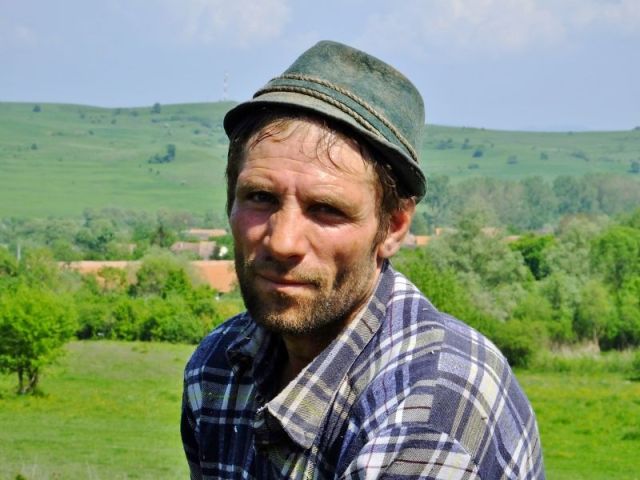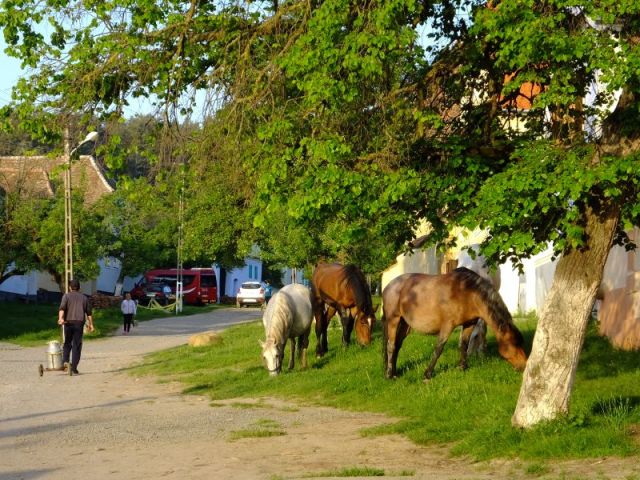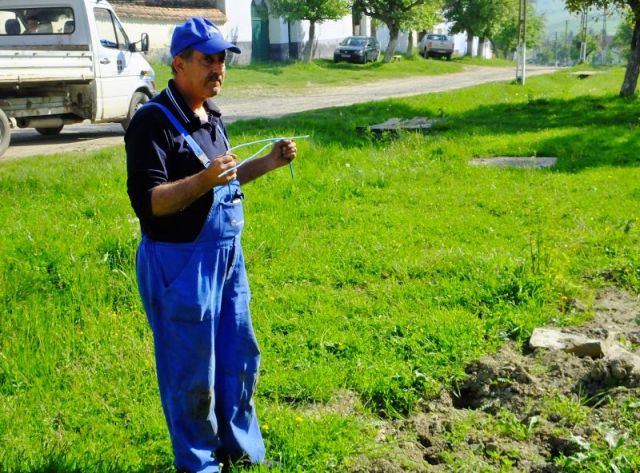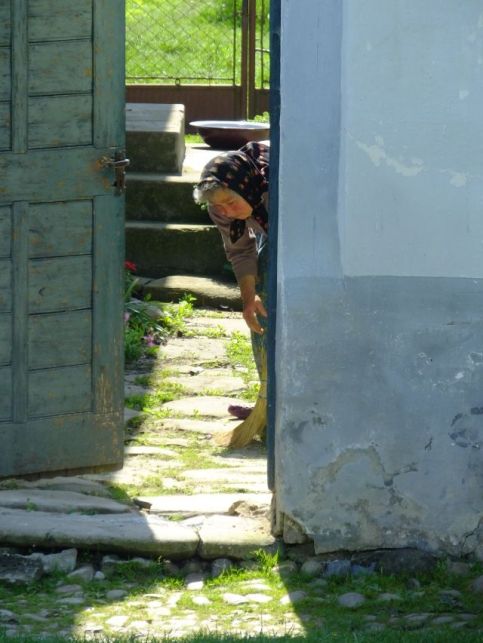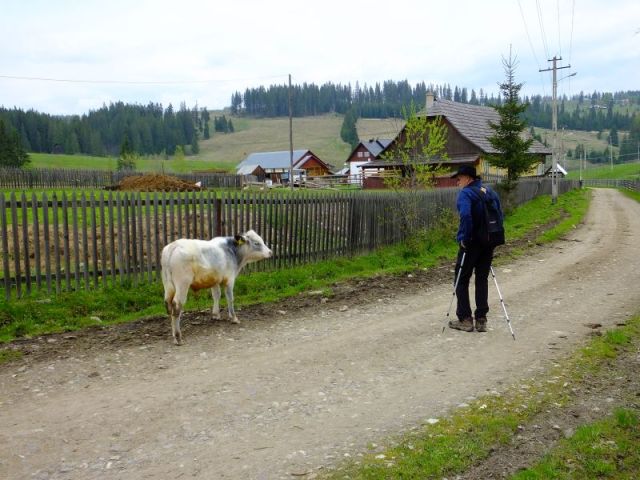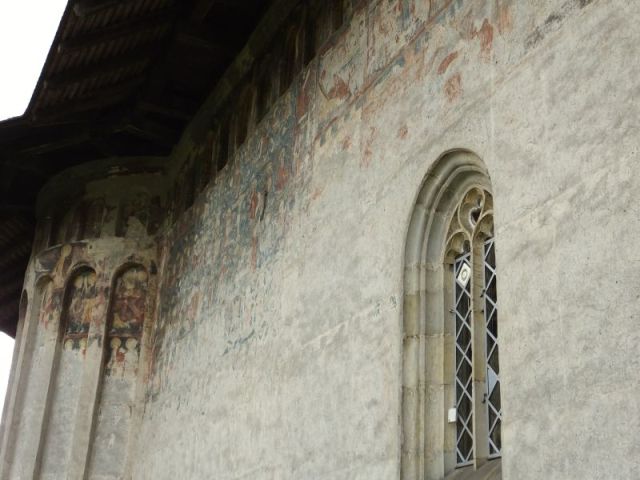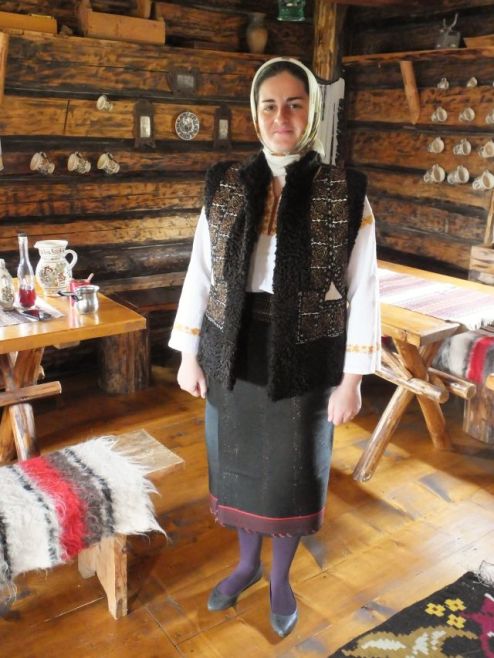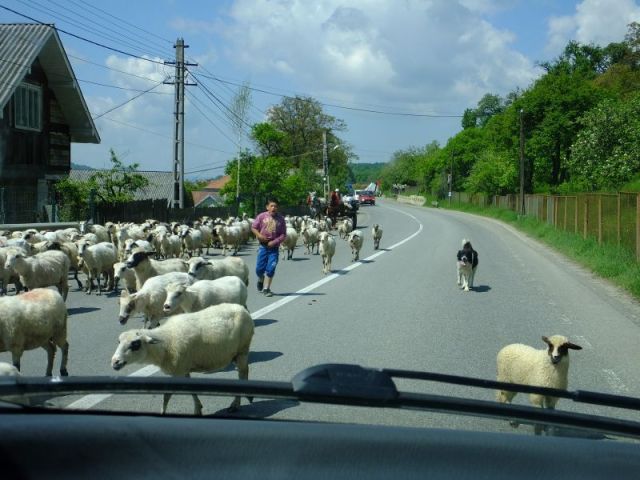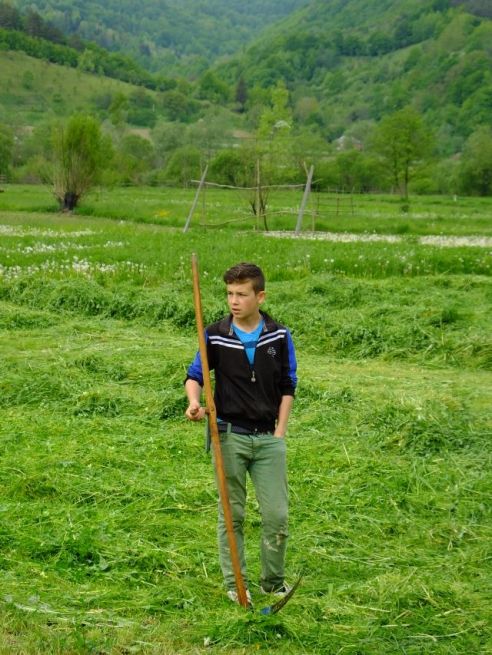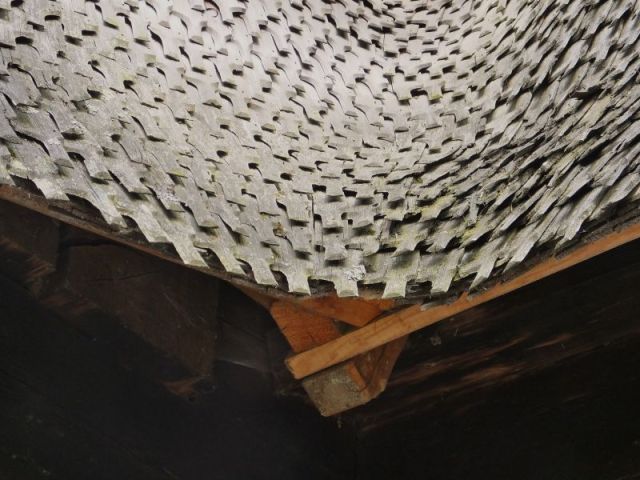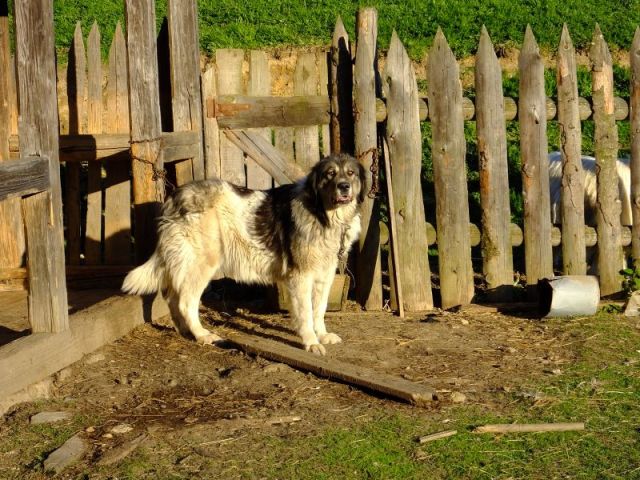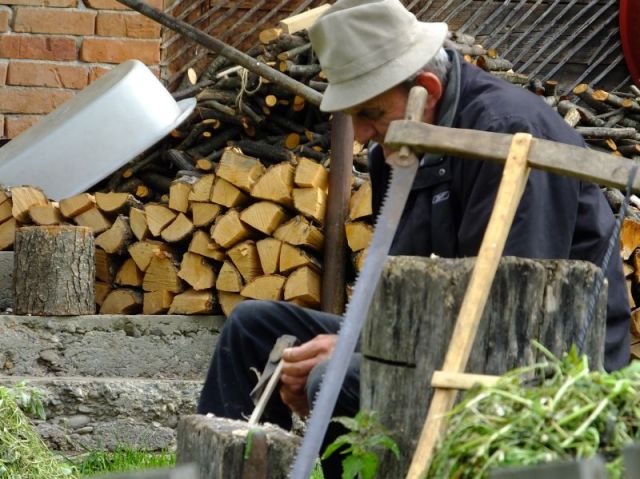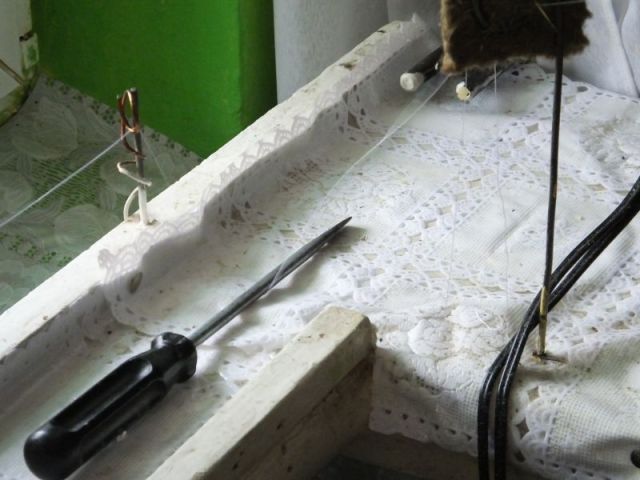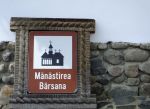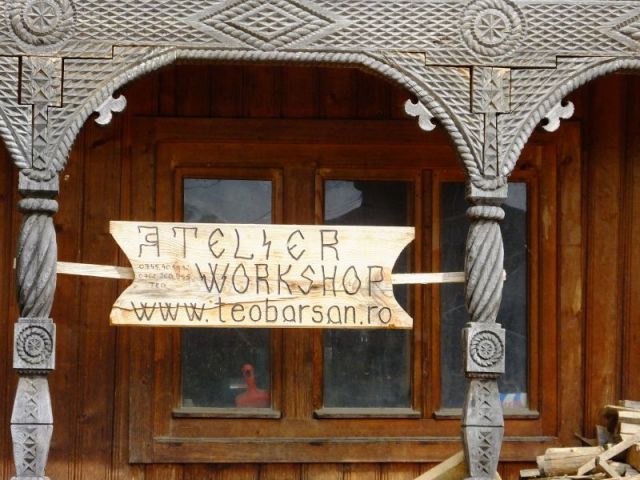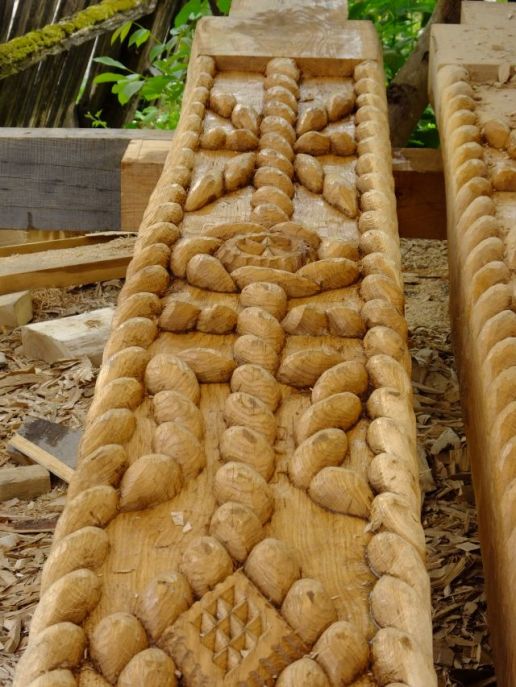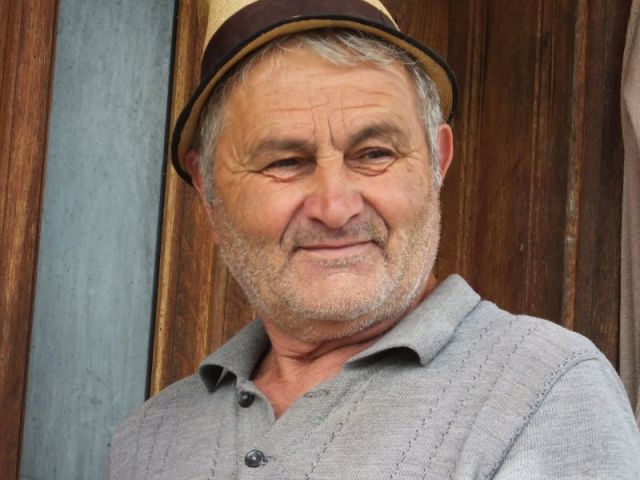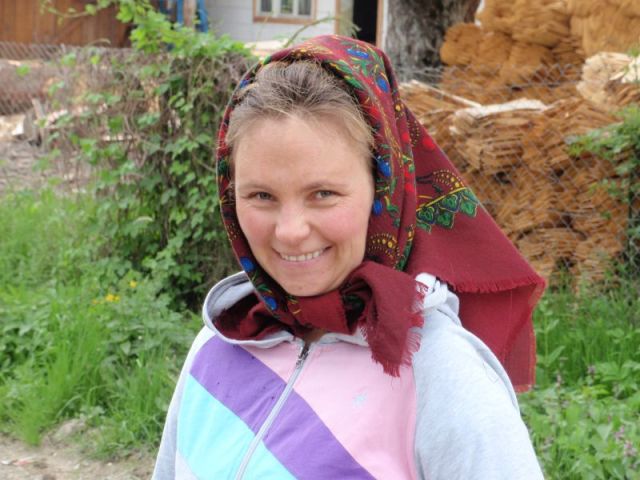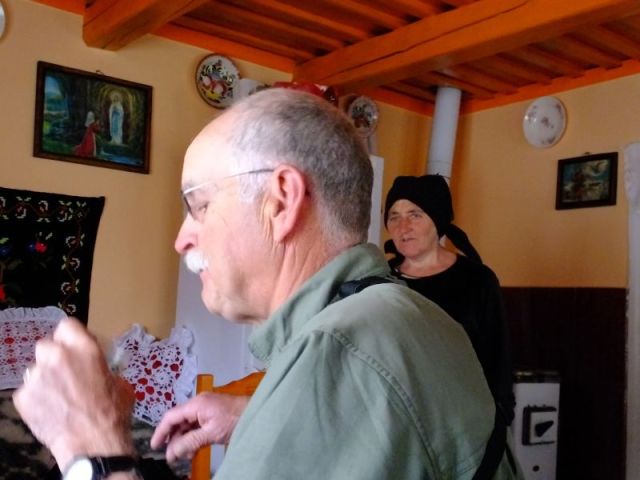Romania final chapter
Well pooh, I woke up in the night unable to breathe through my nose and knew the cold that had been sending subtle warnings to me the last couple of days had arrived in full force. I got up and fumbled through our medicine pouch until I found the Afrin spray, took half of a sleeping pill and went back to sleep. With just two days left of our European adventure I was hoping for once I wouldn’t get sick. Paul never gets sick on our travels and I always come down with some malady it seems.
This morning, Paul and I go down to the courtyard and sit on the bench in front of the main house. Paul is checking on emails and I am admiring the unique ways that Dorin and Ileana have planted flowers in old antiques. We go into breakfast at eight and Dorin serves cheese, bread along with an eggplant spread, juice and of course tea. Ileanna has already left for work so Dorin is in charge of our breakfast.
After we have eaten, the four of us go to the area behind the house and look at the large garden where various kinds of vegetables are being grown. There is a fence between the garden and a grassy area. Here Dorin keeps two sheep, two pigs and a small flock of chickens. Dorin turns the chickens and pigs out of their pens and the pigs happy to be free, go for a gallop around the grassy lot. The sheep are too busy eating grain to pay attention to us.
This morning we are driving to a sheepfold to visit a family who are good friends of Daniels. We are cruising along enjoying the picturesque winding road when Daniel stops by a group of men that are taking a break from working on the road. After Daniel chats briefly with the men, he tells us that they have informed him the road is closed up ahead so we will have to backtrack and take a different route. Was there a road sign announcing “closed road”? Nope, Daniel just noticed that he wasn’t meeting any cars and found this unusual. Now that is observant because I never gave it a second thought!
The alternate route takes us through a village where an outside market is taking place and we stop to take a look. As we wander along the line of tents we find that nearly all of the vendors are selling shoes or clothing. Although we only look at the items for sale the vendors are doing a brisk business with the locals. We walk across the street to a small farmers market. There aren’t a lot of stalls but there is a wide variety of produce for sale. Vegetables, fruits, flowers, chickens, and what appear to be herbs, but the roots are still attached so I don’t know if they are to be used in cooking or to be replanted in one’s garden.
Daniel looks the offerings over and decides to buy some items for the sheep herders. Daniel buys a sackful of cucumbers, some lovely plump strawberries, ripe tomatoes, apples, and we stop at a store to buy some bottles of beer. All of this is stashed in the trunk and we continue on our way.
We are climbing in altitude and we reach the beautiful village of Jina (maybe we bought the beer here) where Daniel parks the car because we are going to walk to the sheepfold from here. That means all the produce Daniel purchased has to be carried to the family’s’ farm which Daniel assures us isn’t too far away. Paul places two bottles of beer in his daypack (they are 1 liter each) along with our water, plus he is able to put a couple other items that Daniel bought in the pack. That leaves Daniel carrying two heavily laden sacks while I am given responsibility for the bag of strawberries.
The three of us walk down a street in Jina which leads out into the country. The dirt road with green meadows on either side is an uphill climb. As we trudge along I swear the weight of the sacks Daniel is carrying have lengthened his arms by an inch or so! There is strawberry juice beginning to accumulate in the bottom of the plastic sack that I am holding and I voice my concern that by the time we reach the shepherds place the ripe berries will be nothing but mush. I’m not sure how far we have walked but Paul offers to spell Daniel and take on the bulging bags of food, to which Daniel agrees. The two men continue to take turns in lugging the gift of produce for the remainder of our hike. I figured out that I can take some of the pressure off the strawberries by letting the sack sit on top of my camera bag, and although a bit awkward, this helps to prevent the crushing of the berries. The bad news is that I couldn’t take any photos of the human mules:).
Paul and I estimate we have walked about two miles as we approach the family abode. We turn left off the main road onto a less traveled track where the shepherds property is located. We happen to meet a neighbor at this point and he tells us the family has moved to their other property for the summer. Luckily the other place is across the road and not much farther to walk. It isn’t long before we reach the gate that leads into the sheepherder’s property and we walk through the pasture to the tiny cabin that the family calls home. Ileana (yep, the same name as the woman at the guesthouse) and Dinu welcome us and invite us into their one room house. The couple’s handsome teenage boys, Gabi and Nicu, appear at the door and look curiously at the foreigners who have come to visit. (I hope I have the names right but someone’s writing is a bit hard to make out).

This seems to be the only photo of the family’s place. The barn is to the right and the house to the left. What a backdrop! Paul’s photo
After introductions, Daniel converses briefly with his friends and then pulls out some photos another client took of the family when he visited this gorgeous area. Oh yeah, Daniel was carrying the large envelope of photos on our trek here too! The prior visitor has taken some wonderful photos of the family and they are all quite taken with the pictures, often exclaiming out loud and smiling broadly as they study the photos. When they have finished looking at the photos, Paul digs our photo book out of his pack to show it to our hosts. The photo book proves to be a hit with the foursome and questions are asked and answered about various pictures in the book via Daniel.
Ileana begins to prepare lunch, (after we have had some horinca of course) and since there are seven of us in the 8X12, (estimated by Paul); room there is no sense in trying to lend a hand as we would just be bumping into one another. It is amazing that four people live in this small space, particularly when two of them are fast growing teenagers! A small dining table sits at one end of the room, two narrow beds are opposite each other against the walls, a small table at the foot of one bed holds the three-burner portable gas stove that Ileana cooks on, and there is a cupboard sitting at the foot of the other bed. Talk about cozy!

Slicing bread. Why Black and white photos? Because the light coming in the windows was so harsh my color photos were not good. I let the computer change them to black and white to try and salvage them
Ileana places a pot of water on to boil and places the beef or pork links that Daniel also brought into the pan. Ileana begins slicing the loaf of bread and Paul takes a photo of her so Ileana jokingly brandishes the knife at Paul, which makes us all laugh. A large block of cheese is placed on the table along with a bowl filled with cucumbers and another dish full of tomatoes. When the meat has cooked the links are placed on the table along with a plate containing pieces of lard. There are only six places set at the table and Ileana watches as the rest of us help ourselves to the food. Paul is peeling a cucumber for the two of us and I am attempting to cut my meat up when one of the boys says something to Daniel. Daniel informs us that both of us are using the wrong edge of the small paring like knives. Well, that is embarrassing, but it really was hard to tell which side of the knives had the sharp edge.
Paul and I both notice that Dinu used his pocket knife to cut up his food and he also impales the food on his knife point using it as a fork when eating the meat. Paul said the boys also used their pocket knives though I did not notice that. I did notice that the three would nearly cut off a bite of bread or piece of lard with their knives before finishing by biting the piece off with their teeth. It was really fascinating to watch this way of eating. When the six of us are nearly finished eating, Ileana puts a large bowl of the strawberries we brought on the table. Paul and I play it safe and don’t eat them but the other diners certainly enjoy them. However, someone makes a comment to Daniel about the condition of the berries. Daniel tells Paul and I that he told them that I was given the responsibility of carrying the strawberries so the bruised and smushed strawberries were my fault! Ha! When the rest of us have finished eating, Ileana sits down and has her lunch. I felt bad that she didn’t eat with us and I don’t know if that is the custom or if there just wasn’t room at the table for her.

Ileana finally gets to eat as Dinu talks on his cell phone. The slices of lard can be seen in the foreground.
There was one more surprise during lunch, though by now Paul and I should expect this, and that was when Dinus’ cell phone rang. Shortly after Dinus’ phone call, Ileana’s phone rang and then after lunch we found the boys, laying in the grass either texting friends or playing games on their cell phones! I don’t think there is any place in the world anymore where cell phones can’t be found!
The two boys have to gather the four milk cows the family is keeping for another owner for the summer, and drive them to the community well for water. Paul, Daniel, and I decide to tag along. One boy walks in front of the cows while the other boy is trailing the docile beasts and we join the queue. The water source is perhaps a quarter-mile away where the system is housed in a tin building. A hollowed out log like those in Viscri is sitting outside the building for the shepherds to water their livestock. The cows drink a little water but they seem more intent in exploring their surroundings which sends one of the boys running downhill to corral the ring leader and herd the cows back to the water trough. When it is obvious that the cows have had their fill of water the youngsters begin herding the cows back home.
Daniel, Paul and I decide to hike farther down the road to enjoy the countryside and the spectacular views no matter which direction you look. From one hilltop we can see Jina in the distance, the white church shining like a beacon, as it sits on the highest point of the village. At another place on our trek, Daniel shows us the general area where a monastery sits hidden by the trees far below us. Turning back, we walk a different road where a valley spreads out below us sprinkled with houses and numerous conical haystacks. This country is just stunning.
Upon our return to the sheepfold, Gabi and Nicu, are in a game of soccer with two other boys. Gabi and Nicu are playing in their rubber boots and it is amazing how they can manipulate the soccer ball despite the awkward footwear. Ileana is milking the one cow that has a calf, the other three cows are not far from calving. We go out to take a look and are surprised to see the baby calf is nursing one side while Ileana is milking out the other side of the cow. That certainly saves time.
Once Ileana is finished milking and has shooed the cow back with her herd mates, we all gather on the porch of the house. Daniel, Paul, and Dinu are sitting on the bench next to the house when they begin trying on each other’s hats, Gabi(I think) grabs Paul’s hat and joins the trio as I snap photos. Ileana not to be left out dons my hat and squeezes in among the guys and I laughingly take pictures.
Dinu rises to his feet and tells Daniel he must take the sheep to water and invites us along. I decline the invitation saying that I am walked out, reminding my companions that we leave this special place to drive back to the guesthouse. Paul and Daniel forego the invitation too, saying it is time that we head back to the guesthouse. We do walk to the gate to watch the flock of sheep being driven out of the pasture by the boys while Dinu walks in front of his flock. Once the wooly sheep are out in the road the boys go back to the house while Dinu leads the sheep to water by himself. Daniel hollers at Dinu who turns to face us and we wave goodbye. Ileana accompanies us down the road for a few minutes and then we say thank you and goodbye to this friendly woman. What delightful people and what a wonderful way to spend our last full day in Romania!
This evening at supper we naturally begin the meal with a brandy glass full of horinca. I have seen Daniel look down at his arm after he has taken a drink of the liquor before and declare that he is watching to see if the hair on his arm is standing up. I don’t know if the hair rising on his arm is a test of the quality of the horinca but I figured he was pulling our leg about his arm hair reacting to the liquor anyway. Tonight I look at his arm too and I’ll be darned if the hair doesn’t lift up. Yikes, that should tell you about the potency of this stuff. I also realized at the sheepfold that after I had a couple sips of horinca that the symptoms of my cold had lessened. Tonight, much to Paul’s astonishment, I drink about half of my glass of white lightning, (slowly) in hopes that it will alleviate my stuffy nose and head. Daniel assures me that horinca is very medicinal. I don’t know if it is coincidence or not but this is the most short-lived and mildest cold I can remember having.
After supper, Dorin tells us some stories, the guy is really funny, and the one I remember the most is the tale of his baptism. According to his mom when he was dipped in the baptismal fount he created his own fountain which happened to baptize the baptismal book the minister was holding. Dorin tells the story while on his feet and he is very animated while reciting the tale which has us howling with laughter.
After supper, we meet the couple’s son for the first time and we visit with the young man briefly. Dorin brings out his hat and his father-in-laws hat and eventually everyone in the group has tried on the hats and posed for photos while wearing them. Despite the fun we are having the day’s activities are catching up with Paul and I and we bid a reluctant good night to everyone.
There is no need to rush around this morning as we don’t have to be at the airport until mid-afternoon. After breakfast, Paul and Daniel work to get us checked in online using Daniels laptop as our tablet isn’t cooperating. After loading our luggage we say so long to our gracious and funny host Dorin and ask him to relay our thanks to his wife.

Paul had two “Eat Beef” hats left and these guys look good in them! Dorin really wanted Paul’s Setson but it was much to large for him. Paul’s photo
 Daniel takes us to one last historical place, Alba Carolina fortress which was built in the 1700’s to defend against the Ottomans. Prior to the fortress this place was known as Alba Luila which was a military and economic center during the Roman occupation.
Daniel takes us to one last historical place, Alba Carolina fortress which was built in the 1700’s to defend against the Ottomans. Prior to the fortress this place was known as Alba Luila which was a military and economic center during the Roman occupation.
As we get ready to walk through what is known as the third gate a man dressed in a guard uniform of the 17th century is patrolling the entrance with his musket hoisted upon his shoulder and stops so I can take a photo of him. Once we enter the square we see several life sized bronzes depicting people from the 16th century scattered around e area. Many monuments have been built here over the years, including one of Michael the Brave sitting astride his steed. We visit two more cathedrals, one being the Romano Catholic Cathedral built in the 15th century. As usual the Cathedrals are beautiful inside and out.
It is time to move on and the highway takes us through an area where sheer rock cliffs dot the landscape. Daniel stops at a restaurant/hotel for lunch where we look over the rugged landscape while we eat. Daniel treats us to a dessert called papanasi insisting we can’t leave Romania without eating this traditional dish. I can still taste the fried pastry that is filled with a sour cream and jam. Out of this world.
Daniel delivers us to the airport and walks into the terminal to make sure our flight is on time. We say goodbye to Daniel and thank him for the excellent time we had touring Romania with him. Enough can’t be said for Daniels willingness to go the extra mile to do the extra things we asked of him. Both Daniel and Cornelia were a huge part of making our Romania adventure such a success!
Our flight from Romania to Luton airport in England went off without a hitch and our driver that is taking us to our hotel near Heathrow is waiting for us. We begin to see signs along the main highway about all the long delays on various routes to the airport but our driver is savvy enough to get off on side roads and a couple of hours later our driver pulls up at our hotel.
After a good night’s sleep, Paul and I are lounging in the room thinking our flight leaves in the middle of the afternoon. Paul decides to check to see if our flight is still on time and discovers that we fly out at 12:45! Holy Smokes, it is a good thing Paul checked when he did. We pack up, check out and go outside the hotel to wait for the free bus that will take us to our terminal. While standing at the bus stop, I hear someone singing the song “I had the time of my life” behind us. Turning around I discover that two teenage Muslim girls are the vocalists. Remember that this song was playing in the restaurant where we ate on our first day in Romania. Weird, and to make it weirder the crummy movie I watch on the way home from Europe ends with this song playing during the credits. Well I guess this was a good theme song for our travel to Europe.
Our flight out of London was delayed for more than two hours and Paul and I knew we weren’t going to make our connecting flight in Dallas. When we did land in Dallas the flight attendant told us that we were lucky to have made it here as our plane landed as one thunderstorm moved out and another one was getting ready to move in. The airline put us in a hotel for the night and luckily we were able to fly to Manhattan the next morning.
When we left Kansas we were wondering if we would have much hay to put up. When we arrived home Paul and I were amazed at the lush, green landscape where ponds that were worryingly low on water were now running out the trickle tubes. It is always good to come home but this time with the drought seemingly broken it was especially wonderful. Nancy

You can just make out the hat pin with the American flag and Kansas flag pinned to Gabi’s(I think) hat. Paul’s photo









